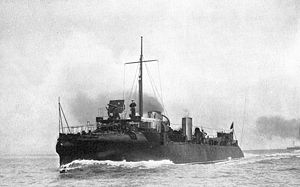- Daring class destroyer (1893)
-

HMS DaringClass overview Builders: John I. Thornycroft & Company, Chiswick Operators: Royal Navy Preceded by: None Succeeded by: Havock-class destroyer Built: 1892–1894 In commission: 1895–1912 Completed: 2 Lost: 1 Scrapped: 1 General characteristics Type: Torpedo Boat Destroyer Displacement: 260 long tons (264 t) light
287.8 long tons (292 t) full loadLength: 185 ft (56 m) Installed power: 4,200 hp (3,132 kW) Propulsion: Thornycroft boilers Speed: 27 knots (50 km/h; 31 mph) Armament: • 1 × 12 pounder gun
• 3 (later 5) × 6 pounder guns
• 3 (later 2) × torpedo tubesTwo Daring class destroyers were the very first torpedo boat destroyers ("TBDs") to be ordered for the Royal Navy, the order being placed on 27 June 1892.
The invention of the self-propelled torpedo by Robert Whitehead and Austrian Navy Captain Giovanni Luppis in 1866, combined with the introduction of small fast torpedo boats (invented by John Ericsson in the late 19th century[citation needed]) posed a threat to battleships: large numbers of torpedo boats could overwhelm a battleship's defences and sink it, or distract the battleship and make it vulnerable to opposing capital ships. Torpedo boats proved devastatingly effective in the Chilean Civil War of 1891.
The defence against torpedo boats was clear: small warships accompanying the fleet that could screen and protect it from attack by torpedo boats. Several European navies developed vessels variously known as torpedo boat "catchers", "hunters" and "destroyers", while the Royal Navy itself operated torpedo gunboats. However, the early designs lacked the range and speed to keep up with the fleet they were supposed to protect. In 1892, the Third Sea Lord, Rear Admiral Jackie Fisher ordered the development of a new type of ships equipped with the then novel water-tube boilers and quick-firing small calibre guns.
Six ships to the specifications circulated by the Admiralty were ordered initially, comprising three different designs each produced by a different shipbuilder:
- HMS Daring and HMS Decoy from John I. Thornycroft & Company.
- HMS Havock and HMS Hornet from Yarrows (the Havock class).
- HMS Ferret and HMS Lynx from Laird, Son & Company (the Ferret class).
These boats all featured a turtleback (i.e. rounded) forecastle that was characteristic of early British TBDs. All six of them were removed from service and disposed of by the end of 1912.
HMS Daring and HMS Decoy were both built by Thornycroft, displaced 260 tons (287.8 tons full load) and were 185 feet in length. They were armed with one 12-pounder gun and three 6-pounder guns, with one fixed 18-in torpedo tube in the bow plus two more torpedo tubes on a revolving mount abaft the two funnels. Later the bow torpedo tube was removed and two more 6-pounder guns added instead. They produced 4,200 hp from their Thornycroft boilers, giving them a top speed of 27 knots. In common with subsequent early Thornycroft boats, they had sloping sterns and double rudders.
See also
 Media related to Daring class destroyer (1893) at Wikimedia Commons
Media related to Daring class destroyer (1893) at Wikimedia CommonsReferences
- Lyon, David (1996). The First Destroyers. ISBN 1-84067-364-8.
- Captain T.D. Manning, (1961). The British Destroyer. Putnam and Co.
Daring-class destroyer (1893)Preceded by: None · Followed by: Havock class
List of destroyer classes of the Royal Navy"26-knotter" type Daring class · Havock class · Ferret class
"27-knotter" type Followed by: B class
List of destroyer classes of the Royal NavyCategories:- Destroyer classes
- Daring class destroyers (1893)
Wikimedia Foundation. 2010.
